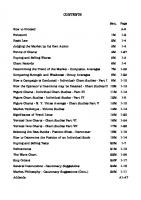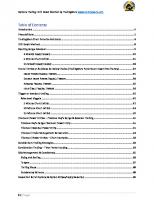The Richard D.Wyckoff Method of Trading and Investing in Stocks
1,080 162 72KB
English Pages 0 [7]
Recommend Papers

- Author / Uploaded
- Richard D. Wyckoff
File loading please wait...
Citation preview
Stocks & Commodities V. 4:1 (14-17): The Wyckoff method Trading and Investing in Stocks by Jack K. Hutson
The Wyckoff method Trading and Investing in Stocks by Jack K. Hutson
Anyone who buys or sells a stock, a bond or a commodity for profit is speculating if he employs intelligent foresight. If he does not, he is gambling. Richard D. Wyckoff, American pioneer in technical stock analysis.
R
ichard Wyckoff's first instruction to students of his stock analysis method published in the 1930s was
quite simple and specific—forget all the decision-making factors you ever used. All you need to know is in the table of stock prices and volumes in your daily newspaper. With this back-to-basics approach, Wyckoff promised to show his students "the real rules of the game" played so adroitly by well-heeled investors with enough capital to pack clout in the market. Although it's hard to imagine anything, especially a stock market technique, remaining viable from the 1930s to the 1980s, The Richard D. Wyckoff Method of Trading and Investing in Stocks has survived the times as a classic. Whatever it lacks in glamour and gee-whiz in this computerized age, it makes up by giving its users a solid foundation for analyzing the fundamental relationships among the market's primary forces. In this respect, it's like the pearls and basic black dress in a woman's wardrobe. It can be embellished but not antiquated. Take a look at Wyckoff's goals—to select only stocks that will move soonest, fastest and farthest in bear or bull markets; to limit losses and let profits run; and to make the most efficient use of investment capital. Hardly an antiquated outlook. It also is a universal theory. The premises are applicable to any open market—stocks, bonds, options, or commodities. David Weis of Memphis, Tenn., editor of the Elliott Wave Commodity Letter, has relied on the Wyckoff method in his commodities trading and analysis for 15 years. "It opened Pandora's box for me," he says. "It gave me a way of understanding what was going on," unlike the other analysis methods that came his way when he became a broker/analyst. A client making large sums of money introduced Weis to Wyckoff's method and Weis has put the method's premises through every trial. "I promise you those principles are still applicable to today's markets," he says. His only supplement to the Wyckoff method is the Elliott Wave principle, for its added insights into the way price movements unfold. I'm not interested in anything else," he explains. "I don't need anything more." The Wyckoff method also struck a chord with a Seattle bond trader who discovered the method several years ago in mid-career. The trader, who today manages a $20 million portfolio, had read voraciously, but found that Wyckoff's view of the market as if it were controlled by a single investor described his own
Article Text
Copyright (c) Technical Analysis Inc.
1
Stocks & Commodities V. 4:1 (14-17): The Wyckoff method Trading and Investing in Stocks by Jack K. Hutson
experiences with market behavior. "It didn't matter to me if it was bonds or gold or stocks," he said, "Wyckoff described it in a way that made sense to me. I had already been through it, I'd seen it." So he adopted Wyckoff's volume analysis and basic attitudes toward trend tops, bottoms and corrections. Wyckoff, himself, was intrigued by the stock market. He learned the market from the bottom up, at a time when experience was the only teacher. His first job in 1888 was as a 15-year-old stock runner, scurrying back and forth on Wall Street, delivering and exchanging securities and payments for a brokerage firm. By 1898 he had advanced to auditor of another brokerage firm and made his first $1,000 profit in the stock market selling 300 shares of a company with a new product—a pneumatic horse collar. At the age of 25, he opened his own brokerage office. He had seen "appalling losses in securities suffered annually by millions of people who do not realize what they are risking and have an amazingly small knowledge of the market." He sent daily letters on market conditions to his clients, and turned his research and writing into a monthly magazine in 1907. As a broker, he saw the behind-the-scenes plays of the large operators and realized "it was possible to judge the future course of the market by its own action . . . that the action of stocks reflected the plans and purposes of those who dominated them. . .that the basic law of Supply and Demand governed all price changes; that the best indicator of the future course of the market was the relation of supply to demand."
" . . . the best indicator of the future course of the market was the relation of supply to demand." He published the first technical analysis method of its kind in 1908 and, at the insistence of his readers, began publishing weekly forecasts in 1911, employing charts of price and volume movements for his analysis. Wyckoff pooh-poohed analysts who used their charts as a kind of Rorschach test, searching for tell-tale shapes and formations that would signal whether to buy, sell or hold steady. "Stock market technique is not an exact science," he would tell his students. "Stock prices are made by the minds of men." In his estimation, mechanical or purely mathematical chart analyses could not compete with finely honed and practiced judgment. Wyckoff also shunned broker's offices, financial reports, news items, earnings reports, and especially tips, rumors, and "the half-baked trading theories expounded in boardrooms and popular books on the stock market." To his way of thinking, an analyst should be a detective uncovering the forces behind price and volume fluctuations, a market psychologist weighing the human motivations that fuel those moves, and a general planning a financial campaign to intercept stocks when the charts show them to be at their most profitable stages. Wyckoff's popularity as an analyst grew by leaps and bounds. Even when he tried to limit the size of his following by nearly doubling the price of his publication, the subscriptions totaled $60,000 in six weeks. By his own account, he "made a great deal of money for myself and my clients and subscribers who
Article Text
Copyright (c) Technical Analysis Inc.
2
Stocks & Commodities V. 4:1 (14-17): The Wyckoff method Trading and Investing in Stocks by Jack K. Hutson
numbered in excess of 200,000" before his health began to fail and he completely turned his publications and advisory services over to his associates in 1928. When his method was published as a correspondence course in 1931, he called it "the cream of what I have learned in 40 years of active experience in Wall Street." His method rests squarely on the law of supply and demand. When demand for a stock exceeds supply, prices rise; when supply is greater than demand, prices decline. He likens the stock market ticker tape to a movie: "Every minute of the day it is demonstrating whether supply or demand is the greater." Wyckoff's method charts price, volume and their relationship over time to judge how the market, groups of stocks and individual issues are reacting to the supply-and-demand tug of war. The search is for turning points—the final top of a rising bull market, the final low in a declining bear market and the crests or troughs of the intermediate and minor moves that come in between. He is guided by the fact that every change in the market consists of waves of buying and selling that last just so long as they can attract a following. When the following is exhausted for the time being, the wave ends and a contrary wave sets in. Small daily waves build into larger 3-to-5-point waves, which eventually build into the bull and bear market swings of 10 to 20 points or more. He acts in harmony with a wave, not against it, and only if the wave is a significant one. His philosophy on accumulating stock: Buy on the down wave, ride through the small-to-medium rising waves until you see an especially strong, breaking wave. Then sell. Complete mastery of the Wyckoff method means working both sides of the waves—covering all shorts and going long at the bottom of a panic, depression or intermediate bear swing as well as selling out all long stocks and going short at the top of a boom or an intermediate bull movement. Gauging these critical turning points in the Wyckoff method is not so much a strict application of mathematics as it is an application of investor psychology. At the heart of Wyckoff's analysis is the knowledge that traders and investors are influenced by tips, news items, rumors, earnings analyses, financial reports, dividend rates, and myriad other sources of information. It isn't important to Wyckoff which of these prompts a buy or sell order—all individual actions boil down to market behavior, as if the fluctuations were the result of one person's investment operation, a 'composite' investor. Wyckoff visualized this composite investor because he knew there are "usually one or more large operators working in every stock. Sometimes there are many." In his day, wealthy individuals or well-informed insiders could fill the role. Today insurance companies investing millions of premium dollars and institutional investors managing pension funds are "large operators" whose decisions impact the market simply by the magnitude of their investments. Wyckoff studied his charts to uncover the motives of these large investors with enough capital to exert a force on the price of stocks and ultimately the entire market. He was not interested in their identity, only in their game plan. When large operators disclose their anticipation of price advances or declines with their purchases or sales, they signal events to come in the market or an individual stock. Wyckoff's method is built on three basic types of charts— Vertical Line (Bar), Figure (Point & Figure), and one he developed, the Wave chart. Vertical Line charts ( Figure 1) record an individual stock, group or composite average's high, low and closing prices plus their volume. From vertical line charts, investors
Article Text
Copyright (c) Technical Analysis Inc.
3
Stocks & Commodities V. 4:1 (14-17): The Wyckoff method Trading and Investing in Stocks by Jack K. Hutson
FIGURE 1:
Stocks & Commodities V. 4:1 (14-17): The Wyckoff method Trading and Investing in Stocks by Jack K. Hutson
FIGURE 2:
FIGURE 3:
Stocks & Commodities V. 4:1 (14-17): The Wyckoff method Trading and Investing in Stocks by Jack K. Hutson
following the Wyckoff method can determine the direction in which prices are moving, the most opportune time for buying, selling or closing out, and at what prices to place their stop orders. Figure (Point & Figure) charts (Figure 2) follow price changes only from one whole point to the next, focusing on price level while ignoring time. From these, Wyckoff's investors forecast the approximate number of points a stock, a group of stocks or the composite averages should move.
"Complete mastery of the Wyckoff method means working both sides of the wares...." His Wave chart (Figure 3) records the aggregate price of at least five leading stocks much like stock index bar charts today. These choices are not permanent. The group is adjusted to include stocks that are continuously active in an industry and indicate real leadership. The wave chart gives investors a means of detecting critical points in the market's travel from one wave to another, frequently warning of coming changes days before they are apparent in the composite averages. At the very minimum, an investor experienced in the Wyckoff method can follow the stock market with a daily financial newspaper, a notebook, and an hour a day in a quiet place. "The best results I ever had in judging the market and trading," writes Wyckoff, "were when I could devote only one hour a day to study of the market, planning my campaigns and giving instructions." Obviously, investment capital isn't a prerequisite to studying the Wyckoff method. Practicing trades on paper is free, and Wyckoff is a staunch advocate of practice now or lose money in the long run. Even initiates who feel they have graduated from paper trading are advised by Wyckoff to begin their investing with small, equal lots of the three, five, 10 or 20 best stocks indicated by the charts. Many times, as the years go by, we forget how or why we got to our current trading technique. Many times, too, an investor who wants to enter technical analysis is bewildered by the choices of methodology, or unfamiliar with the principles guiding the schools of thought. Wyckoff's method is valuable to either situation and in the next months, we will take you through it, step-by-step. We'll look in-depth at his charts, apply them to modern stock market activity, walk through each of his buying and selling tests, and work on the finer points of market activity and actual transactions. Our aim, as Wyckoff said, is to show you the "real" rules of the game. Glossary
Short—Sale of an investment instrument not yet owned in the hope of making a covering purchase later at a lower price, thereby making a profit. Long—Obtaining ownership of an investment instrument such as a security, futures contract or option (as call). Cover—to offset or neutralize a prior transaction such as buying an equivalent number of shares and deliver against a short position. Accumulate a line—Adding to a previous market position.
Article Text
Copyright (c) Technical Analysis Inc.
4
Stocks & Commodities V. 4:1 (14-17): The Wyckoff method Trading and Investing in Stocks by Jack K. Hutson
Issue-- A class ownership such as common stock, bond, option or contract. Trade-- The act or process of buying and/or selling. Price-- The amount of money for which an issue is bought or sold. Volume-- The number of issues traded over a specific time period such as a day. Stop or Stop Loss Order-- Instructions to buy or sell an issue when its market price meets or exceeds a specified price. Bear-- One who expects a decline in market prices (short). Bull-- One who expects a rise in market prices (long).
Copyright (c) Technical Analysis Inc.
5







![Energy Trading and Investing [2 ed.]
1259835391, 9781259835384, 1259835383](https://ebin.pub/img/200x200/energy-trading-and-investing-2nbsped-1259835391-9781259835384-1259835383.jpg)
![The Nature of Trends: Strategies and Concepts for Successful Investing and Trading (Wiley Trading) [1 ed.]
047082235X, 9780470822357](https://ebin.pub/img/200x200/the-nature-of-trends-strategies-and-concepts-for-successful-investing-and-trading-wiley-trading-1nbsped-047082235x-9780470822357.jpg)
